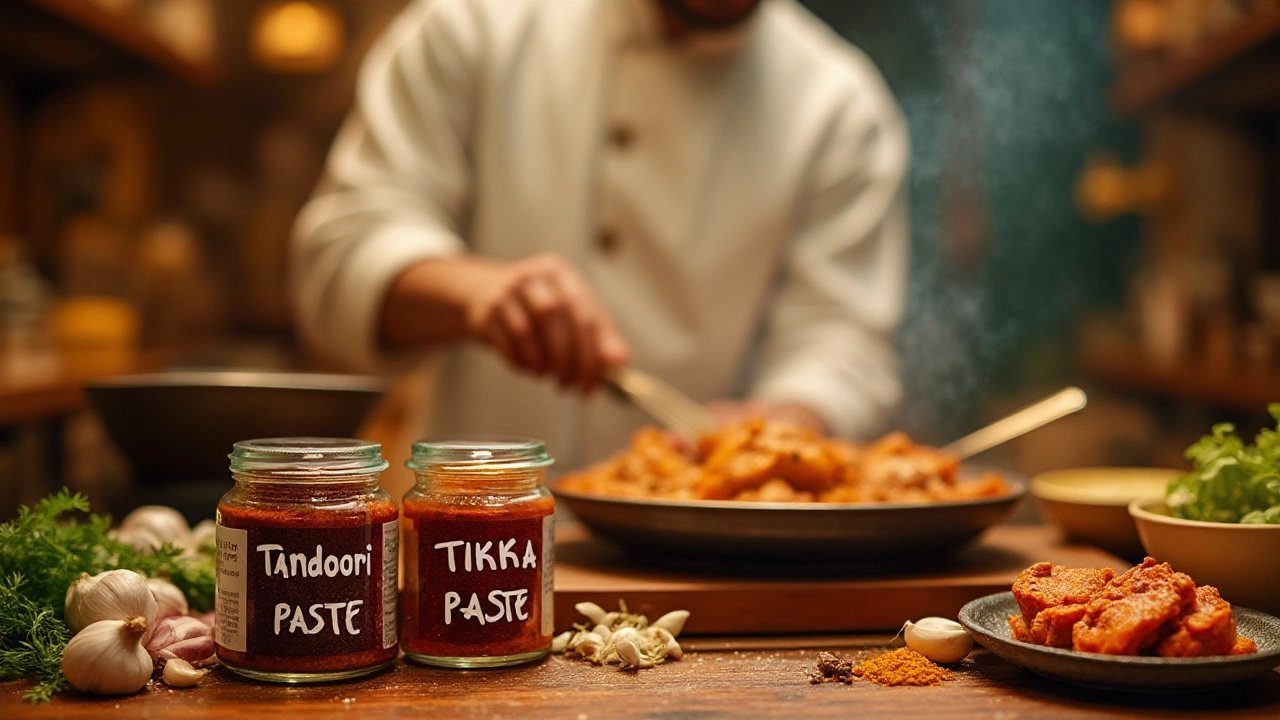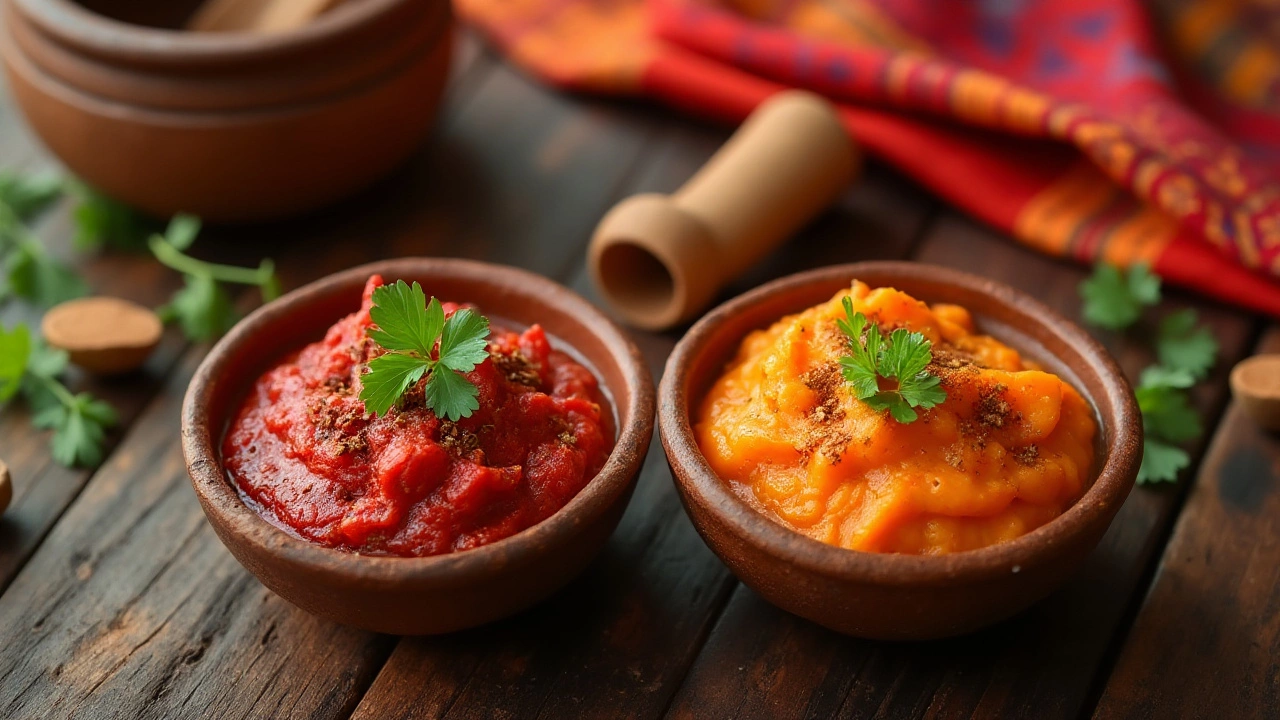Tandoori vs Tikka: Unveiling the Differences in Flavor and Use
 Jan, 21 2025
Jan, 21 2025
Exploring the tantalizing world of Indian cuisine, one might wonder about the subtle but significant differences between tandoori and tikka pastes. While both are bursting with spices and flavors, they serve unique purposes in the culinary arts. Whether you are trying to marinate chicken for a BBQ or preparing a dish that bursts with authentic Indian flavors, knowing which paste to use can make all the difference.
Both tandoori and tikka pastes share foundational spices, which include things like cumin, coriander, and garam masala. However, the emphasis on specific ingredients varies. For instance, tandoori paste often incorporates yogurt, giving it a tangy zing and a softer, richer marinade quality, suitable for high-temperature cooking seen in a tandoor oven.
Tikka paste, on the other hand, hones in on a thicker, more concentrated blend, often omitting the yogurt or using it sparingly, which brings out a zestier and more intense spice identity. This isn’t to say one is better than the other; their unique profiles simply cater to different culinary needs.
- Introduction to Pastes
- Ingredients and Preparation
- Flavor Profiles
- Common Uses in Cooking
- Tips for Home Cooks
- Conclusion and Recommendation
Introduction to Pastes
The world of culinary arts teems with a diverse palette of flavors, and Indian cuisine stands out with its rich use of spices and pastes. Among these, tandoori paste and tikka paste have found a cherished place in kitchens around the globe. These pastes serve as a foundation for creating iconic Indian dishes, yet they are distinct in their composition, flavor, and application.
Understanding these pastes begins with their origin. Both hail from the vibrant North of India, where the art of marination plays a crucial role in cooking. The tandoori paste, named after the traditional clay oven 'tandoor,' is renowned for its capability to infuse a smoky flavor into the food, achieved through the spices absorbed into the meat as it cooks at high temperatures. Anyone who has dined in an Indian restaurant has likely encountered this delightful smoky aroma long before their first bite.
In contrast, tikka refers to cuts or chunks of marinated food, often grilled on skewers. The marinade or paste used in preparing tikka is somewhat drier than its tandoori counterpart. Interestingly, the advent of tikka came from a necessity to adapt grilled foods to a more urban context where tandoors weren't easily accessible. The paste serves as both a tenderizer and a flavor enhancer, preparing the chunks of meat or vegetables to be cooked evenly over open flames or within modern oven grills.
The components of these pastes play a crucial role in defining their unique attributes. Both start with a base of ginger, garlic, cumin, and sometimes garam masala, but tandoori paste takes a step further with the addition of yogurt and lemon juice. This not only adds flavor but breaks down proteins, lending tenderness to the meat. During my time researching and experimenting in the kitchen, I found that swapping yogurt for a plant-based alternative works wonders in a vegan tandoori preparation, allowing the same rich flavor profile for those who prefer or require such diets.
Intriguingly, these pastes do not just draw the line at traditional uses. With a culinary world that thrives on fusion, chefs around the world have started using them in unexpected ways—from pizza toppings to mixing into burger patties, these pastes prove to be versatile. A study published in the Culinary Journal of India indicated a growth trend in the utilization of Indian spice pastes in Western cuisines, attributing it to an increasing appreciation of bold flavors globally.
"The versatility of Indian pastes lies not only in their traditional recipes but also in their adaptability, making them a staple in kitchens looking to explore a fusion of tastes," said Chef Anil Kapoor, a renowned culinary expert specializing in Indian food innovations.
Thus, the journey of tandoori paste and tikka paste through the culinary world is as rich and varied as their ingredients. By diving deeper into understanding their complexities and applications, home cooks and professional chefs alike can enhance their culinary repertoire, creating not just dishes, but experiences that are memorable and enjoyable.
Ingredients and Preparation
Diving into the delightful world of Indian cuisine, the preparation of tandoori paste begins with a harmonious blend of spices designed to bring out deep and flavorful notes in meats and vegetables. This paste typically uses a mixture of yogurt, which serves as both a tenderizer and a flavor enhancer. Adding a spoonful of lemon juice can introduce some zing, complementing the creamy texture of the yogurt. This is usually combined with spices like garam masala, coriander, cumin, and the slightly smoky flavor of paprika. For those seeking a spicy kick, a dash of cayenne pepper can provide that extra heat.
In contrast, tikka paste dials up the spice level and tends to focus more on a concentrated spice profile without relying as heavily on yogurt. Often, tikka paste includes chilies both in powder and raw form, lending it a bold and fiery character. Onion and garlic pastes are added too, contributing to a fuller, richer taste that envelops the dish uniformly. This type of paste takes well to meats such as chicken or lamb, ensuring a robust flavor that stands up to various cooking methods.
"Cooking with a well-prepared paste not only enhances the dish but ensures that every bite is an experience," shares noted Indian chef, Vir Sanghvi. "Understanding the essence of the ingredients allows a chef to elevate the dish to new heights."
Preparation of these pastes is not merely about mixing ingredients. It involves a delicate balance of roasting and blending spices to unlock their full potential. Roasting allows the essential oils in spices to emerge, providing depth and complexity. Once the spices are ready, using a pestle and mortar can help to create a paste with the perfect consistency. For those pressed for time, a quality blender can also do the trick, though it's worth noting that traditional methods often add a rustic character to the paste that can be irresistible.
If you are adventurous and looking to customize your preparation, consider experimenting by adjusting the quantities of each spice. This flexibility means that every dish can be unique, a testament to the cook's creativity and understanding of flavor dynamics. With both tandoori and tikka pastes, the sky's the limit in terms of innovation. Embrace regional variations such as adding saffron to tandoori paste for a royal flair, or incorporating fenugreek into tikka for an earthy undertone.

Flavor Profiles
When diving into the rich tapestry of Indian cuisine, one immediately appreciates the intricate dance of flavors that pastes like tandoori and tikka introduce. Their differences, though subtle to some, reflect diverse culinary applications and traditions. To truly appreciate them, we need to explore their flavor profiles, which are both unique and exciting.
Tandoori paste is often characterized by its vibrant red hue and a complex layering of spices. This paste typically includes ingredients such as cumin, garam masala, ginger, garlic, and a medley of chili powders, which together create a smoky, slightly spicy essence. A key component adding to this paste's distinctive taste is yogurt. The yogurt not only acts as a tenderizing agent for meats but also gives a creamy and mild tangy backdrop to the fiery spices. This balance makes it perfect for being applied on meats that are cooked at high temperatures, imparting a rich flavor without overwhelming the palate. The texture provided by the yogurt allows the paste to adhere well to various surfaces, making it ideal for marinating meats that will be exposed to open flames or ovens.
On the flip side, tikka paste is generally thicker and less reliant on yogurt for its consistency and flavor profile. This paste amplifies its spice content with ingredients like cardamom, fenugreek, and sometimes even saffron to add a subtle aromatic component. While it maintains the chili-induced heat, tikka paste surprises with its zestier character which makes it particularly suited for dishes that demand a punchier taste. When cooked, the spices meld together to produce a hearty and robust flavor profile that is both warm and invigorating. The absence or minimal presence of yogurt in tikka paste tends to concentrate its flavor intensity, making this paste a favorite for grilling, where bold flavors are celebrated and sought after.
"Indian food is too often reduced to color and heat. The real magic lies in the balance of spices, each playing its part to produce an extraordinary sensory experience," explains food critic and spice enthusiast, Anjali Pathak.
Understanding these differences allows one to not only choose the appropriate paste for a dish but also to appreciate the way each element sings in harmony with the others. Whether you are embracing the vibrant complexity of tandoori or the sharp zest of tikka, each paste promises a flavor adventure that captures the essence of Indian culinary tradition. When next you indulge in preparing these pastes, consider their flavors as the key that unlocks the door to a culinary journey of spice and delight.
Common Uses in Cooking
When it comes to culinary applications, the versatility of tandoori paste and tikka paste helps create a variety of delightful dishes. These pastes are primarily used as marinades to infuse meats and vegetables with the robust flavors typical of Indian cuisine. While both pastes share some common ingredients, their different formulations endow them with unique characteristics that suit different dishes and cooking methods. In particular, tandoori paste is frequently used for foods cooked at high temperatures, such as in the roaring heat of a tandoor oven.
This distinctive red paste, with its yogurt base brightened by spices like cumin and cayenne pepper, ideal for marinating proteins such as chicken, lamb, or even paneer. A common cooking method is to marinate chicken in tandoori paste for several hours or overnight, allowing the spices to thoroughly work their way through the meat, resulting in the mouthwatering, fiery-red tandoori chicken that many people know and love.
Tandoori chicken: Originating from the Punjab region, this dish revolutionized North Indian cuisine and gained international popularity for its spicy, smoky aroma.
Tikka paste, meanwhile, finds its starring role in dishes where a more concentrated spice punch is desired. Since tikka paste tends to have a rich, intense flavor profile, it's often used for grilling or baking dishes where the dominant spices need to hold their own, even as the food is subjected to less heat than a tandoor. For instance, chicken tikka involves pieces of meat marinated in tikka paste, then skewered and cooked until perfectly tender. As tikka paste can include robust spices like paprika and turmeric, its boldness helps maintain the vivid taste sambas even against any accompanying removals or sauces that are served alongside.
In addition to traditional uses, creative chefs are finding ways to incorporate these pastes into fusion cuisines. Tandoori paste can be integrated into oven-baked pizzas or even used as a seasoning base for roasted vegetables, adding a burst of flavor that complements the roasted depth of the veggies. On the other hand, tikka paste can make a dramatic transformation, turning into a savory spread for sandwiches or a zesty zing in creamy pasta dishes. Given their unique flavors, when used wisely, these pastes can significantly enhance the culinary palette available to home cooks.
It's also interesting to note the growing trend towards ready-made pastes available in grocery stores, as they retain much of the authenticity of traditionally ground spice blends.
| Type of Paste | Typical Ingredients | Ideal Cooking Method |
|---|---|---|
| Tandoori | Yogurt, garam masala, cayenne | Tandoor, grill |
| Tikka | Paprika, turmeric, coriander | Skewer, oven bake |

Tips for Home Cooks
If you're a home cook looking to dive into the delights of Indian cuisine, understanding the use of tandoori paste and tikka paste is crucial to master recipes with authenticity. To start with, always consider the flavor profile you're aiming for when deciding between these two. A tandoori paste offers a creamy, slightly tangy finish thanks to yogurt, perfect for those wanting a tender and milder spice hit. On the other hand, tikka paste provides an in-your-face spice experience, with a more vibrant and earthy undertone without the need for dairy.
When preparing chicken dishes, many cooks swear by marinating the meat for a minimum of four hours to let the flavors seep into the fibers. For those making tandoori chicken, aim for a longer marination—overnight if possible—as it allows the yogurt and spices to tenderize the meat, making it succulent. As for the tikka chicken, you can get away with a slightly shorter timeframe, but the heat from the spices benefits from some rest time with the flesh. If you're after that charred restaurant-like finish, consider using a grill or open flame, as these cooking methods enhance the smokiness inherent in both pastes.
It’s worth noting a handy tip for those looking to tone down the heat: before adding any paste, you can first sauté some onions and garlic in oil. Adding the paste after this step tends to bring out a depth of flavor without overpowering heat. Additionally, consider serving these dishes alongside cooling agents, such as cucumber raita or simple yogurt dips, which can balance out the spices beautifully. As renowned chef Atul Kochhar puts it, "Balance is the essence of Indian cooking. If a dish is too fiery, you've forgotten to add its counterweight."
Don't limit the use of these pastes to meats alone. Try experimenting with vegetables or paneer cheese. A mix of cauliflower and peas, for instance, can withstand the bold flavors of tikka paste when sautéed to create a vegetarian delight. Meanwhile, your paneer can be diced, gently coated in tandoori paste, and baked for a creamy-rich snack or appetizer. For those more adventurous, these pastes can even substitute your regular pizza sauce to give your pizzas a delectable twist.
Lastly, always store your pastes properly to maintain their potency. Airtight containers in the fridge ensure that they last for weeks, with minimal loss of flavor. If you're making your own pastes—which many seasoned cooks advocate for freshness—consider making them in bulk and freezing portions to extend their life. Armed with these tips, you'll be creating delectable Indian dishes like a seasoned pro in no time.
Conclusion and Recommendation
Diving into the aromatic world of Indian cooking can be both exciting and a tad overwhelming, especially when deciding between the lovely tandoori paste and the vibrant tikka paste. Each carries a legacy of flavor and purpose that is uniquely its own. Understanding these differences not only enhances your cultural knowledge but also improves your culinary skills, offering richer, more authentic flavor experiences. On one hand, tandoori paste, with its yogurt base and earthy spices, thrives in high-heat settings, making it perfect for oven-roasted or grilled dishes that need that spicy, smoky finish. This paste's ability to lock in moisture while providing a robust flavor ensures the meat stays tender. On the other hand, the tikka paste, though similar at a glance, is usually thicker and spicier, often crafted without yogurt, emphasizing intense marination that seeps deep into meats or vegetables.
"Mastering the art of balancing spices is key to perfecting any Indian dish," noted Madhur Jaffrey, an acclaimed actress and food writer known for her Indian cooking expertise.
So, which should one choose? It depends largely on the cooking method and desired flavor intensity. Those aiming for a creamy, milder taste may lean towards tandoori paste for smoked or roasted recipes. This is particularly true if you're using a traditional tandoor oven to achieve those delightful charred notes. However, if you're opting for something zestier and perhaps a bit more toothsome and dry, tikka paste would be your go-to. Notably, tikka paste excels in stovetop cooking, where you might want to craft a sizzling hot dish that bursts with intricate spice blends.
A beautiful aspect of cooking is experimentation. Don't hesitate to modify a classic recipe to see how both these pastes can be substituted or even combined for a dual-layered flavor profile. You might discover new favorites that honor the past yet appeal to modern palates. Whether you're using either paste for traditional recipes or creative cross-cultural dishes, these ingredients can be a game changer in your kitchen. Remember to always keep a quality paste in your pantry, as they provide a quick fix to elevate mundane meals.
